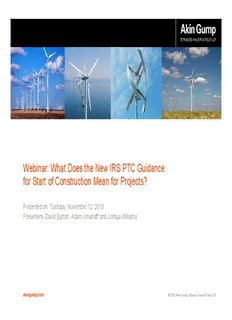
for Start of Construction Mean for Proj - Akin Gump Strauss Hauer PDF
Preview for Start of Construction Mean for Proj - Akin Gump Strauss Hauer
Webinar: What Does the New IRS PTC Guidance ffoorr SSttaarrtt ooff CCoonnssttrruuccttiioonn MMeeaann ffoorr PPrroojjeeccttss?? Presented on: Tuesday, November 12, 2013 Presenters: David Burton, Adam Umanoff and Joshua Williams akingump.com © 2013 Akin Gump Strauss Hauer & Feld LLP PPTTCC SSttaarrtt ooff CCoonnssttrruuccttiioonn GGuuiiddaannccee - BBaacckkggrroouunndd The American Taxpayer Relief Act of 2012 enacted in the first week ooff 22001133 eexxtteennddeedd tthhee pprroodduuccttiioonn ttaaxx ccrreeddiitt ((PPTTCC)) ffoorr pprroojjeeccttss tthhaatt start construction in 2013 ● The Act contained no outside date by which time the project must bbee ccoommpplleetteedd ● The Act permits PTC eligible projects to waive the PTC and elect a 30% investment tax credit TThhee IIRRSS ffiinnaalllly iissssueedd gguiiddaannccee iinn NNoottiiccee 22001133-2299 oonn AApprriill 1155tthh 1 PPTTCC SSttaarrtt ooff CCoonnssttrruuccttiioonn - IIRRSS NNoottiicceess 22001133-2299 // 22001133-6600 IRS Notice 2013-29 is generally favorable The Notice provides two methods to start construction in 2013: ● Commence physical work of a significant nature in 2013; or ● AA saffe hharbbor requiiriing iincuriing att lleastt 55%% off tthhe costt off tthhe project in 2013 ● Both methods generally follow the Treasury Cash Grant guidance bbuutt wwiitthh ssoommee kkeeyy ddiiffffeerreenncceess Notice 2013-29 added an additional requirement not contained in the PTC extension statute or in the Treasuryy Cash Grant Guidance: the taxpayer must continually pursue completion of the facility IRS then issued Notice 2013-60 providing a safe harbor for the continuous requirement, so long as the project is placed in service by the end of 2015 2 TThheeoorreettiiccaallllyy PPrroojjeeccttss ccaann bbee CCoommpplleettee AAfftteerr 22001155 A project that is complete after 2015, can still qualify for the PTC if there was “ccoonnttiinnuuoouuss” wwoorrkk ● Post-2015 projects should expect IRS scrutiny and tax equity investor skepticism FFoorr nnoonn-55%% ssaaffee hhaarrbboorr pprroojjeeccttss,, tthhee ccoonnttiinnuuoouuss wwoorrkk mmuusstt bbee ● Work must be “integral” to the facility (e.g., “transmission” does not count) ● Preliminary work (e.g., planning and permits) does not count For 5% safe harbor projects, the continuous efforts includes ● Paying or incurring additional amounts included in the basis of the facility ● Entering binding written contracts for components or future work ● Obtaining necessary permits ● Performing work integral to the facility (see above) 3 SSoolluuttiioonnss ttoo CCoommmmoonn PPrroobblleemmss 4 PPrroojjeecctt iiss uunnaabbllee ttoo oobbttaaiinn aa TTSSAA?? Buy a collection of components, rather than whole turbines Ask the BOP Contractor to help. The BOP Contractor orders parts and materials that equal 5% of the total ultimate tax basis of the project. ●● YYoouu ccaann llooookk tthhrroouugghh ttoo tthhee BBOOPP ccoonnttrraaccttoorr’ss ssppeenndd, ssoo lloonngg aass yyoouu hhaavvee aa bbiinnddiinngg written contract with the BOP contractor with any liquidated damages not limited to less than 5% of the face amount of the contract ● The BOP contractor must pay for the parts and materials in 2013 and they must be ddeelliivveerreedd wwiitthhiinn 33.55 mmoonntthhss ooff ppaayymmeenntt ● The BOP contractor must be able to trace the parts and materials to your project ● The project company does not have to pay the BOP contractor anything in 2013 5 UUnnaabbllee ttoo RRaaiissee tthhee CCaasshh ttoo MMeeeett tthhee 55%% SSaaffee HHaarrbboorr “Physical Work of a Significant Nature” to start construction in 2013 ●● OOnnllyy rreellyy oonn iitt iiff ccaasshh ssttrraappppeedd ● Tax equity investors will be skeptical – may pass on your project or put your project at the bottom of their list What counts? ● Excavating turbine sites ● Pouring foundations ● Setting anchor bolts ● Step-up transformer ● Roads only if for “operations and maintenance” Many subjective issues as to what is “significant” ● What is “significant” – IRS’s example suggests 20% of the turbine sites ● Was it “significant” if you have to later move the turbine sites or the holes have to be re-dug after the spring thaw ●● IIff yyoouu aarree bbuuiillddiinngg aa rrooaadd, hhooww mmuucchh rrooaadd ddoo yyoouu nneeeedd ttoo bbuuiilldd ttoo bbee “ssiiggnniiffiiccaanntt” – 100 feet, 1 mile, 2 miles? 6 NNoott SSuurree aabboouutt PPPPAA oorr IInntteerrccoonnnneeccttiioonn SSttaattuuss?? Meet the 5% safe harbor in 2013 (or physical work of significant in 2013) TThhen suspendd workk unttiill tthhe PPPPAA andd//or iintterconnecttiion iis obbttaiinedd But be certain the project is placed in service by the end of 2015 7 UUnnssuurree ooff tthhee PPrroojjeecctt SSiittee Notice 2013-60 extended the “master contract” rules to the 5% safe harbor TThhere iis no requiirementt tto iiddenttiiffy tthhe llocattiion off tthhe projjectt iin 22001133 Developer parent enters into a “master contract” with an OEM and orders standard parts in 2013 to meet the 5% test ●● PPaarrttss mmuusstt bbee ppaaiidd ffoorr iinn 22001133 aanndd ddeelliivveerryy wwiitthhiinn 33.55 mmoonntthhss ooff ppaayymmeenntt After 2013, the developer parent locks in sites and assigns its rights under the 2013 “master contract” to special purpose companies organized for each pprojject Would want to be certain projects were all complete by the end of 2015 to avoid the “continuous” construction requirements 8 NNoott EEnnoouugghh TTiimmee ttoo SShhiipp “55%%” CCoommppoonneennttss ttoo PPrroojjeecctt SSiittee If a project plans to meet the 5% test, the components ordered with the 5% ppaayymmeenntt mmuusstt bbee ddeelliivveerreedd wwiitthhiinn 33.55 mmoonntthhss ooff ppaayymmeenntt Delivery does not have to be to the project site or even to the U.S. The project could lease warehouse space abroad (e.g., Germany, China) aanndd hhaavvee tthhee ccoommppoonneennttss ddeelliivveerreedd tthheerree ● Title and risk of loss must transfer to the project ● The project should have a signed lease and be paying rent ● The pprojject should be respponsible for insuringg the compponents once delivered 9
Description: